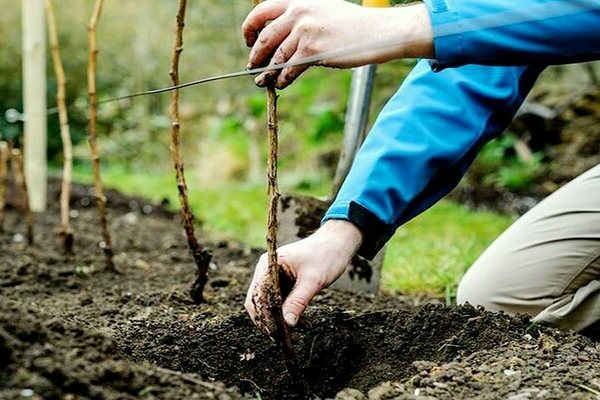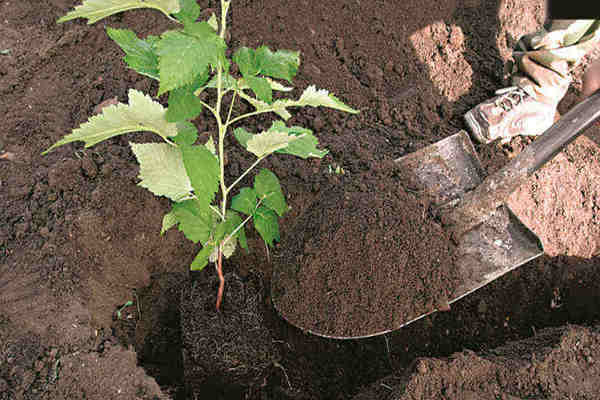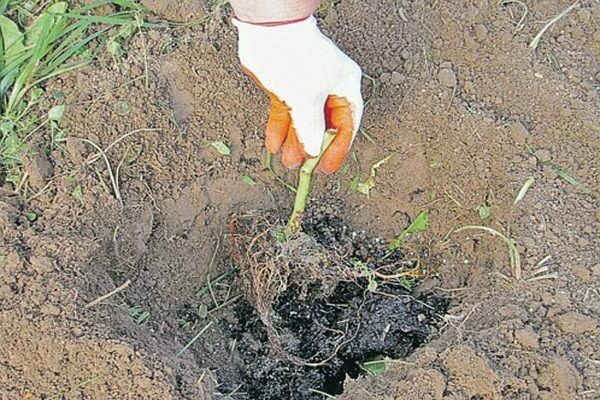Planting raspberries
Content:
Raspberry is considered an unpretentious plant. However, she also needs to be looked after. In order to grow raspberries on your site and get a good harvest, you need to adhere to the rules of agricultural technology. Planting and caring for raspberries deserves special attention. Since the further development of the plant depends on this.
Raspberries are considered a very healthy plant, as their fruits contain many micronutrients. Raspberries are often consumed fresh, as well as frozen, make jam and compotes, jams from it.
Many gardeners dry raspberries and add them to compotes in winter. And if you plant it correctly on your site, you will be able to feast on delicious fruits in the same summer.
Planting raspberries and care: choosing a planting time

planting raspberries and care
Timely planting of raspberries and care is the key to a good harvest. Of course, the best time to plant is based on regional climatic conditions. In the southern regions, autumn planting is preferred.
The fact is that autumn is quite warm in the south of our country, so the seedlings root well and are prepared for wintering. Therefore, after the snow melts in early spring, raspberries will already begin to develop, and in the summer, you may get your first harvest.
It is best to plant raspberries in this case in October. In the spring in the southern regions, raspberries are planted only in the most extreme cases. The fact is that in the south there is no spring as such, but it gradually turns into summer.
Therefore, the plant does not always understand when it should form a root system, and when to discard fruit buds. In the middle lane, all raspberries are planted either in the fall or in the spring.
Usually, when choosing a variety, growers indicate when it is best to do so.
Consider the following fact, if your raspberry variety is not very frost-resistant, then it is best to plant raspberries in the spring, but you will not see only fruits this year. If raspberries are more frost-resistant, then they can be planted in the fall.
In the northern regions of our country, raspberries are planted in spring. This must be done in order for the seedlings to harden and overwinter over the summer. But the autumn planting of seedlings can destroy them. The fact is that in the north, winter comes earlier. But if there is not so much snow, then the seedlings will simply die.
Choosing seedlings

planting raspberries and care
The choice of seedlings is considered one of the most important points. You can either grow them yourself, or contact a specialized agricultural store or market for help.
Usually they sell annual or biennial seedlings with a sufficiently developed stem and root system. If you come to the store or the market, you need to pay attention to the stem of the seedling.
It shouldn't be too thick or thin. The seedling will need a lot of nutrients for a thick stem, so it is likely to develop more slowly. However, too thin stems are also not good.
The fact is that such seedlings are usually weak. Therefore, you should choose seedlings with a medium stem thickness. Pay attention to the length of the trunk and the root system. They must be interconnected.
What is it about, you ask? If the stem of the seedling is long enough, then the root system should be very developed. After all, such a stem will need a lot of nutrients. Therefore, you should not choose bushes with a too long trunk.
Pay attention to the root system of the seedling. It is advisable to choose a plant with a well-developed rhizome.The roots should not be brown. This suggests that the root system is too old and overdried.
Make sure that there are replacement buds on the seedling, since it is from them that new branches will develop in the future.
The seedling should also be free of any cracks, rot and swelling. This suggests that the plant is injured. Usually, many gardeners buy seedlings immediately with loose green leaves.
However, the fact is that such seedlings were dug up after the start of sap flow, which is not true. A good seedling is transplanted only after all the foliage has fallen off and the sap flow stops.
Choosing a place

Before planting raspberries, you need to choose the right place. The site should be well lit by the sun, as raspberries love warmth and sunlight. Remember that there should be no drafts at the landing site, raspberries do not like cold winds.
Therefore, it is good to choose places near agricultural buildings or fences. Moreover, it is desirable to arrange the rows from south to north, this will allow the raspberries to see the sun throughout the day.
Do not plant raspberries near trees. In the shade, it will not actively grow, and the bushes will suffer from a lack of light. It is undesirable to plant raspberries near strawberries, tomatoes and potatoes.
If we talk about the choice of soil, then you should give preference to well-drained, sandy, loose and fertile soil.
How to plant. Raspberry remontant - planting and care

Before planting raspberries, you will need to prepare your site. Soil preparation usually begins in the fall. You will need to first dig up the ground with one shovel bayonet and remove all weeds.
Before loosening the soil, you can apply organic fertilizers to the soil in accordance with the norms. In order to structure the soil, sand is usually added to the heavy soil. Often, gardeners apply organic fertilizers directly to the planting holes.
Usually, one well has a couple of kilograms of humus, 20 or 30 grams of potassium salt and superphosphate. Compost is often added to the planting pits. Raspberries are usually planted either in rows or in bushes.
However, in both the first and second planting methods, you should maintain a certain distance between the plants, since excessive thickening interferes with the growth of raspberries.
If you decide to plant raspberries in rows, then you will need to dig in the furrows in advance. The bushes are placed in prepared rows, and then, spreading the roots, they are added dropwise. It is important to remember that the distance between plants must be at least 50 cm.
Sometimes it is more advisable to leave a distance of up to 1 meter, since over time, raspberries will fill all the empty surrounding space. And new shoots will delight you with fresh herbs next year.
A distance of up to 2 meters should be left in the row spacing. If you choose a tall variety of raspberries, then the distance will need to be increased. Do not mix varieties with each other, as the fruits in this case will not always be of high quality.
Often, raspberries are not planted in rows, but in a bush method. To do this, you will need to dig holes. Remember that the distance between the bushes must also be at least one meter.
In order to adjust the planting depth, you need to dig a hole so deep that the top neck of the bush is at the level of the topsoil.
If you deeply deepen the root system, then it will be difficult for new shoots to break through the thickness of the earth, and if you bury the seedling not too deep, then its root system may freeze.
After you spread the roots in the holes, dig in the holes and water the plants well. After that, many gardeners mulch the soil under the bushes.
Now it is clear how important the quality planting and care of raspberries is.
Raspberries: planting and care outdoors - different planting methods

Planting and grooming raspberries are breeding methods. There are several ways.New seedlings can be grown very quickly using shoot propagation. Raspberry has a developed root system, so it fills up all the empty surrounding space very quickly.
After a young seedling appears next to the mother bush, you can already separate it from the mother plant and plant it in a new habitat. The seedlings need to be dug into holes or trenches, and the replacement buds should be covered with earth.
After that, the bush should be watered abundantly with water, and the soil should be mulched. Over time, the seedlings will need to be pruned in order for their development to proceed more intensively.
Raspberries are often planted with cuttings. To do this, you do not need to spend a huge amount of funds that usually go to buy seedlings in specialized stores. In the fall, you should cut the cuttings, in other words, branches with a length of 10 - 20 cm.
Do not use very thick shoots for this, as they need a lot of nutrients for development, which means that they take root very poorly. It is best to choose small branches.
The cuttings will need to be sprinkled with earth or wet sand, and then placed in a cool room, preferably in the basement. In the spring, you will need to dig in the garden, and then plant the cuttings there at a slight slope.
Of course, not all plants will take root, however, shoots will grow from many cuttings, which means that they can be transplanted to a permanent habitat. The longest way to grow seedlings is to propagate raspberries with seeds.
In order to get seeds, you will need to pick ripe berries and grind them on a sheet of paper until you get seeds. After that, the seeds are dried and then planted in pots, mixing the earth with sand.
Seeds should be planted in not very deep holes, and the soil should be constantly watered and kept in the shade. After the seeds have germinated, the seedlings can be transplanted into other containers. However, this is a rather long and painstaking process.
Tapestry

Often, gardeners use trellises to prevent the bushes from breaking. To do this, pegs or columns are dug in near each row in the raspberry tree. And then a wire is tied to them, this must be done so that the raspberry shoots can be tied to this structure. Often, gardeners stretch several rows of wire between the posts.
How to care for raspberries
Of course, planting is very important, but without proper care, you will not get a high yield. Therefore, raspberries need to be watered regularly, cut and tied in a timely manner. Remember that you will need to regularly remove weeds as well as mulch the soil.
This is necessary so that nutrients and moisture remain in the soil longer, which means that raspberries grow well. If we talk about pruning, then this should be done in the fall.
Usually, growers remove weak and diseased branches. It is recommended to leave no more than 7 branches on one raspberry bush. Follow our recommendations, plant your raspberries correctly and get a high and bountiful harvest.

